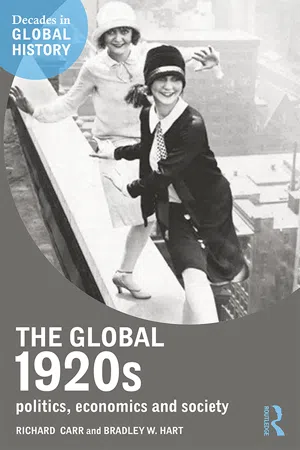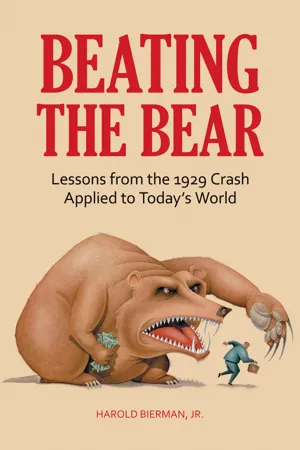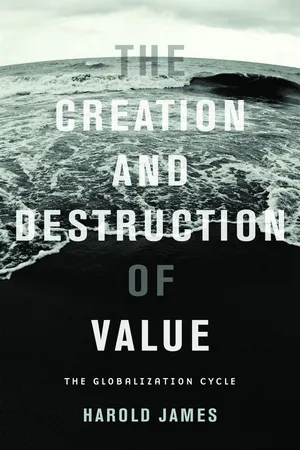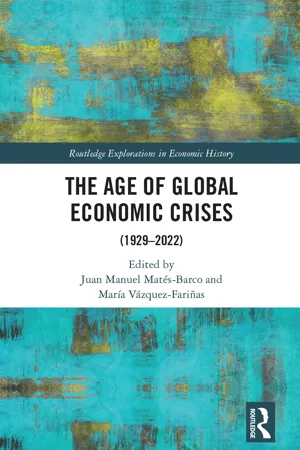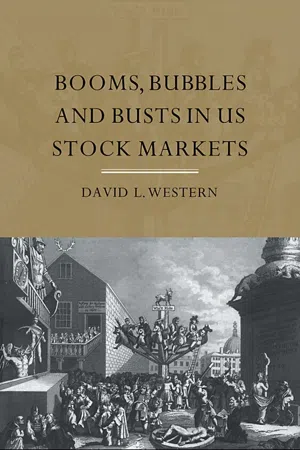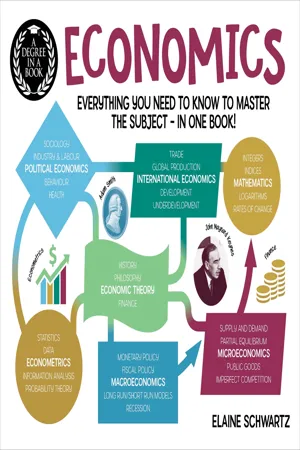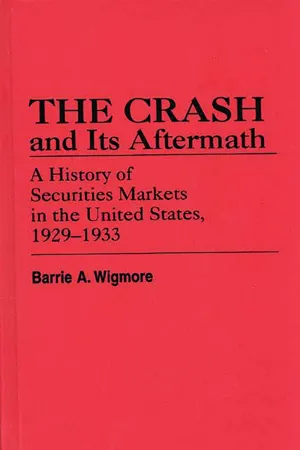History
Stock Market Crash 1929
The Stock Market Crash of 1929 was a devastating event that marked the beginning of the Great Depression. It led to a widespread economic downturn, massive unemployment, and severe financial hardship for millions of people. The crash was triggered by a combination of over-speculation, excessive borrowing, and a lack of government regulation in the stock market.
Written by Perlego with AI-assistance
Related key terms
1 of 5
12 Key excerpts on "Stock Market Crash 1929"
- eBook - ePub
The Global 1920s
Politics, economics and society
- Richard Carr, Bradley W. Hart(Authors)
- 2016(Publication Date)
- Routledge(Publisher)
The Economist in London was already hailing the development as ‘a landmark in post-war financial history’. It continued thatSuch safe returns on capital were, for the time being, over and would not return for over two decades. The 1920s ended with perhaps their most defining moment still playing out.the share boom of 1926–29 originated in a period of industrial prosperity which has never been surpassed in the world’s history. The stock market became a cynosure of interest for the whole American nation, high and low, rich and poor. While the boom lasted Wall Street was a market for the world’s floating resources, since to speculate in that centre, or to lend to others for that purpose, afforded a higher rate of return than any other form of contemporary activity.(The Economist, 2 November 1929)Unsurprisingly, therefore, the crash of 1929, and the events that followed, became seared in the American psyche. By the mid-1930s, the country was plunging into the series of events that would become known as the Great Depression and the world would soon follow suit. But what factors had led to this catastrophic economic collapse? After all, as the previous chapter has noted, the US stock market had crashed before, only to recover in a fairly short time. There had been extended recessions – even depressions – before. Yet the 1929 crash was different – the stock market did recover, somewhat, only to plunge again and again. This chapter considers the causes and immediate effects of the 1929 stock market crash and its effects around the world. The following chapter examines both intellectual and government policy responses to the events of 1929, and while the vast majority of the Great Depression took place in the 1930s, the foundations of what would come later were laid in the final months of the 1920s.Causes of the crash
The American stock market crash of 1929 did not happen in a vacuum and was in fact the result of long-standing factors affecting the US economy. ‘In 1929’, economist John Kenneth Galbraith wrote, ‘the economy was headed for trouble. Eventually that trouble was violently reflected in Wall Street’ (Galbraith 1961 : 93). Galbraith blamed the crash on widespread speculation in stocks that exceeded all rationality, coupled with an overproduction of goods and a downturn in American agriculture. After the crash took place, he argued, it was made worse by the heavy concentration of wealth in the hands of a very few (discussed in chapter 2 on class in the present book); poor corporate practices that included regularly using income to pay off substantial debts; a weak banking structure that quickly began to fail; other countries owing the Unites States too much money (discussed in the previous chapter) and relying heavily on the US economy; and poor economic policy making (‘it seems certain that the economists and those who offered economic counsel in the late twenties and early thirties were almost uniquely perverse’, Galbraith 1961 - eBook - PDF
Beating the Bear
Lessons from the 1929 Crash Applied to Today's World
- Harold Bierman Jr.(Author)
- 2010(Publication Date)
- Praeger(Publisher)
In 2008, the stock market again crashed. The 2008–2009 crash was actually more severe than the 1929–1930 crash. We should look to the events of 1929 in order to better understand the events of 2008–2009. The first lesson for an investor is that even in a normal year, the stock market can fall 50 percent in a matter of months. The investor who does not recognize that fact is vulnerable to unnecessarily large losses. The stock market is volatile and always will be. Diversify! This page intentionally left blank Chapter 1 HOW HIGH IS HIGH? THE STOCK MARKETS IN 1929 AND 2008 However, contemporary and historical accounts have failed to find even a smoking gun, let alone a culprit. ·Rappoport and White (1993, p. 570) On Black Thursday, October 24, 1929, the stock market (New York Stock Exchange) fell 34 points, a 9 percent drop for the day. The trading volume was approximately three times the normal daily volume for the first nine months of the year. There was a selling panic. But the series of events leading to the crash actually started before that date. THE STOCK MARKET 1922–1932 Table 1.1 shows the average of the highs and lows of the Dow Jones Industrial Stock Index for 1922 to 1932. Using the information of Table 1.1, from 1922 to 1929 stocks rose in value by 218.7 percent. This is equivalent to an 18 percent annual growth rate in value for the seven years. From the low of 245.6 in 1928 to the high of 386 in 1929, there was a 57 percent growth; but using the 290.0 mea- sure for 1929, the increase for 1929 was only 15 percent. From 1929 to 1932, stocks lost 73 percent of their value (different indices measured at different times would give different measures of the increases and decreases). The price increases were large but not beyond comprehen- sion, given the real prosperity taking place in the United States. The price decreases from 1929 to 1932 were consistent with the fact that by 1932, - eBook - PDF
The Creation and Destruction of Value
The Globalization Cycle
- Harold James(Author)
- 2009(Publication Date)
- Harvard University Press(Publisher)
and transformed a rather ordinary economic down-turn into the Great Depression. 1929 AS A MODEL The U.S. stock market crash of October 1929 is in-disputably history’s most famous financial collapse. It is evoked wherever and whenever financial senti-ment becomes nervous. Policy recommendations for the following eighty years have consistently been made on the basis of analyses or presumptions of what went wrong in 1929. In particular, John Maynard Keynes’s General The-ory of Employment, Interest, and Money (1936) has at the heart of its diagnosis a critique not of the general op-eration of the stock exchange but specifically of the American market and its peculiar experience: its pro-pensity to encourage a destabilizing and irrational speculation, which followed from the obsession of market participants with psychological rather than economic dynamics and expectations. The problem for Keynes lay fundamentally in a system of valua-tion in which values had no necessary or direct corre-spondence to long-term productivity. As a result, the American market became a casino with an inherently 4 3 1929 OR 1931 ? destabilizing quality. It was uniquely volatile because of the extent of popular participation, while more ex-clusive or “aristocratic” markets were less vulnerable. A conventional valuation which is established as the outcome of the mass psychology of a large number of ignorant individuals is liable to change violently as the result of a sudden fluc-tuation of opinion due to factors which do not really make much difference to the prospective yield; since there will be no strong roots of con-viction to hold it steady . . . . The actual, private object of the most skilled investment today is “to beat the gun,” as the Americans so well ex-press it, to outwit the crowd, and to pass the bad, or depreciating, half-crown to the other fel-low . - eBook - ePub
Why Stock Markets Crash
Critical Events in Complex Financial Systems
- Didier Sornette(Author)
- 2017(Publication Date)
- Princeton University Press(Publisher)
Figure 1.3 .) The Great Depression that followed put 13 million Americans out of work. Two thousand investment firms went under, and the American banking industry underwent the biggest structural changes of its history, as a new era of government regulation began. Roosevelt’s New Deal politics would follow.FIG . 1.3. The front page of the October 30, 1929 New York Times exclaimed the massive loss on Wall Street. It worked hard to ease fear among panicked investors—without success, as history has shown.The October 1929 crash is a vivid illustration of several remarkable features often associated with crashes. First, stock market crashes are often unforeseen for most people, especially economists. “In a few months, I expect to see the stock market much higher than today.” Those words were pronounced by Irving Fisher, America’s distinguished and famous economist and professor of economics at Yale University, 14 days before Wall Street crashed on Black Tuesday, October 29, 1929.“A severe depression such as 1920–21 is outside the range of probability. We are not facing a protracted liquidation.” This was the analysis offered days after the crash by the Harvard Economic Society to its subscribers. After continuous and erroneous optimistic forecasts, the society closed its doors in 1932. Thus, the two most renowned economic forecasting institutes in America at the time failed to predict that crash and depression were forthcoming and continued with their optimistic views, even as the Great Depression took hold of America. The reason is simple: the prediction of trend-reversals constitutes by far the most difficult challenge posed to forecasters and is very unreliable, especially within the linear framework of standard (auto-regressive) economic models.A second general feature exemplified by the October 1929 event is that a financial collapse has never happened when things look bad. On the contrary, macroeconomic flows look good before crashes. Before every collapse, economists say the economy is in the best of all worlds. Everything looks rosy, stock markets go up and up, and macroeconomic flows (output, employment, etc.) appear to be improving further and further. This explains why a crash catches most people, especially economists, totally by surprise. The good times are invariably extrapolated linearly into the future. Is it not perceived as senseless by most people in a time of general euphoria to talk about crash and depression? - eBook - PDF
- Rik W. Hafer, Scott E. Hein(Authors)
- 2006(Publication Date)
- Greenwood(Publisher)
Although a detailed discussion is left for Chapter Six, these changes came in the wake of massive fraud and stock price manipulation in the market. In all, they attempted to raise the regulatory barriers for such be- havior and to improve the flow of information to investors. These laws established the foundation for stock market regulation in the United States and in many other countries. THE CRASH OF 1987: COULD IT HAPPEN AGAIN? On Tuesday, October 20, 1987, the headline of the New York Times related the previous day’s financial calamity: ‘‘Stocks Plunge 508 Points, A Drop of 22.6%; 604 Million Volume Nearly Doubles Record.’’ Another article on the front page stated the question that leaped to everyone’s mind: ‘‘Does 1987 Equal 1929?’’ As readers across the country and around the world tried to digest the news, little did they know that while another ‘‘Black Monday’’ marked the onset of the 1987 crash, the stock market nearly ceased to operate the next day. Was 1987 like 1929? In some ways the answer is yes. In percentage terms, the October 19, 1987, drop exceeded that of October 28, 1929: 22.6 versus 12.8. In other ways, however, the two crashes are distinctly different. What made the 1987 crash much different than 1929 was the response of the A Brief History of the U.S. Stock Market 23 Federal Reserve. Indeed, it is testament to their response in 1987 that not only was there no ‘‘great depression’’ in the wake of the 1987 crash, but the economy suffered only a brief slowdown in its growth. Figure 2.3 shows the behavior of the DJIA in the decade of the 1980s. Compared to the 1920s (Figure 2.2), both market expansions begin in the aftermath of a severe economic recession: The recession of 1982–84 is (thus far) the worst recession in the post–World War II period. - eBook - ePub
- Lisa L. Ossian(Author)
- 2012(Publication Date)
- University of Missouri(Publisher)
32On November 5, for the first time in those two volatile weeks, the stock ticker tape caught up with the market and printed the final quotation within half an hour of the close. On November 13, stock prices seemed to still be “reeling” as three hundred stocks reached new lows for 1929. The ticker that day could not keep up until 2 hours and 12 minutes after closing, and on November 14 the ticker took an additional 2 hours and 47 minutes. The Burlington Daily Hawk-Eye commented, “No responsible person in Wall street would venture a prediction as to how much longer the decline would run.”33 Some analysts now believe that the crash did not officially end until Thursday, November 14, 1929—three weeks after Black Thursday. Economists have estimated the losses for those three weeks at $50 billion, losses that would have not only national but also international consequences.34After the market collapse, stories circulated and escalated about the number of suicides by investors who had lost everything, but the suicide wave after the crash remains actually one more of myth than reality. The number of self-inflicted deaths did not increase statistically in New York or Iowa, although this idea has added to the overall drama of the crash scenario.35Some suicides did result from financial worries, and these stories often made front-page news. Many investors were certainly stunned and depressed, as historian Robert Goldston notes, but did not immediately consider such a violent, personal action as suicide.36 But as time passed, the painful losses for some were sometimes too much to bear. Businessman Lee Fellows, part of an old family and mayor for the last two years of Keosauqua, had worried over personal financial troubles following the crash. On a morning in early November, his wife discovered a letter of intentions and then found his body in the barn loft. Five children and his widow mourned his death.37 - eBook - ePub
The Age of Global Economic Crises
(1929-2022)
- Juan Manuel Matés-Barco, María Vázquez-Fariñas, Juan Manuel Matés-Barco, María Vázquez-Fariñas(Authors)
- 2023(Publication Date)
- Routledge(Publisher)
Finally, the crisis was transmitted to the rest of the world through the lack of coordination, falling prices, and the mechanisms of the gold standard (Eichengreen 1992; Wolf 2010). At the same time, misinterpreted fiscal orthodoxy and protectionism aggravated the situation. Declining revenues inclined governments to reduce expenditures and increase taxes, right in the middle of the crisis, in order to achieve a balanced budget. Moreover, from 1931, all countries increased their levels of protection, making trade more difficult. The economic policies that had been pursued in previous years with positive results had completely opposite effects. The protectionism introduced in most countries led to a decline in exports and a fall in income.The brake on the situation occurred in October 1929, but despite its brutality it came in stages. The crisis manifested itself on 24 October – Black Thursday – when nearly 13 million securities were offered with almost no demand. The banks intervened in order to halt the fall and briefly managed to restore confidence. By the end of Black Thursday, share prices had fallen by between 12 and 25 points. On Monday, 28 October, the collapse began without any possibility of rescue. On that day, a total of 9,250,000 shares went on sale. Industrial assets were down 49 points and bankers were unwilling to buy any more securities. On 29 October – Black Tuesday – the panic triggered a new spate of stock market sell-offs (33 million shares), causing a terrible fall in the value of shares (Table 1.3 ).The Dow-Jones index of the New York Stock Exchange between September 1929 and January 1933 shows that the values of 30 companies fell from an average of $364.90 to $62.70 per share; the 20 government debt securities dropped from $141.90 to $28; and the stock prices of 20 railway companies declined from $180 to $28.10. Between October 1929 and July 1933 – the bottom of the depression – the total value of traded capital fell by $74 billion. In the latter year, the national income of the United States did not reach $40 billion. - eBook - ePub
- David L. Western(Author)
- 2004(Publication Date)
- Taylor & Francis(Publisher)
10: The great asset price bubble of 1929
Introduction
Rarely does an economic crisis scar the minds of people for life, but the Great Depression is the exception. Many years after the event, even when many ordinary people had become millionaires, they remained frugal in their lifestyles. Fear of another depression burnt the importance of thrift into their mindsets. Given the magnitude of the disaster, and its long aftermath, it should not come as a surprise that governments introduced regulatory changes in the 1930s that were aimed at reducing speculative tendencies within the economic and investment arenas. The financial sector was a major target, as it significantly fuelled the boom of the 1920s, as was the stock broking fraternity that fostered ‘buying on margin’. Nevertheless, it was the individual speculator’s greed that drove the quest for quick capital gains, rather than medium term dividends, and so the speculator could accept a major slice of the blame for the economic and social crisis that ensued. What were causes of the Great Depression? How important were speculative forces in this crash? What lessons have we learnt? Could history repeat itself? This chapter examines these questions in the light of the recent boom in US stocks prices. Of particular interest is the degree to which speculative forces overshadowed real economy-wide forces in driving the crash of 1929.Seeds of the bust in the 1920s
There were economic developments in the 1920s that may have spurred the rise of the stock market later in the decade. The economic power of the United States was given a boost post First World War as Europe was still recovering from the ravages of that war. There was a race to lift inventory levels and so a boom developed in 1920–1. The domestic economy was also undergoing a transformation, as an industrial organization revolution saw US companies develop new management techniques, generate economies of scale and scope and benefit from innovation as science was applied more to industrial problems. Such a transformation is analogous to the ‘peace dividend’ spoken of after the end of the Cold War in the 1990s. Hence, real factors or better economic fundamentals may have laid the foundations for the improved economic performance of US companies in terms of earnings and dividends throughout the 1920s. Higher productivity could then explain the ‘real bubble’ in stocks from early 1927 until October 1929. - eBook - ePub
- David Western(Author)
- 2020(Publication Date)
- Routledge(Publisher)
10 The great asset price bubble of 1929Introduction
Rarely does an economic crisis scar the minds of people for life, but the Great Depression is the exception. Many years after the event, even when many ordinary people had become millionaires, they remained frugal in their lifestyles. Fear of another depression burnt the importance of thrift into their mindsets. Given the magnitude of the disaster, and its long aftermath, it should not come as a surprise that governments introduced regulatory changes in the 1930s that were aimed at reducing speculative tendencies within the economic and investment arenas. The financial sector was a major target, as it significantly fuelled the boom of the 1920s, as was the stock broking fraternity that fostered ‘buying on margin’. Nevertheless, it was the individual speculator’s greed that drove the quest for quick capital gains, rather than medium term dividends, and so the speculator could accept a major slice of the blame for the economic and social crisis that ensued. What were causes of the Great Depression? How important were speculative forces in this crash? What lessons have we learnt? Could history repeat itself? This chapter examines these questions in the light of the recent boom in US stocks prices. Of particular interest is the degree to which speculative forces overshadowed real economy-wide forces in driving the crash of 1929.Seeds of the bust in the 1920s
There were economic developments in the 1920s that may have spurred the rise of the stock market later in the decade. The economic power of the United States was given a boost post First World War as Europe was still recovering from the ravages of that war. There was a race to lift inventory levels and so a boom developed in 1920–1. The domestic economy was also undergoing a transformation, as an industrial organization revolution saw US companies develop new management techniques, generate economies of scale and scope and benefit from innovation as science was applied more to industrial problems. Such a transformation is analogous to the ‘peace dividend’ spoken of after the end of the Cold War in the 1990s. Hence, real factors or better economic fundamentals may have laid the foundations for the improved economic performance of US companies in terms of earnings and dividends throughout the 1920s. Higher productivity could then explain the ‘real bubble’ in stocks from early 1927 until October 1929. - eBook - ePub
A History of Financial Crises
Dreams and Follies of Expectations
- Cihan Bilginsoy(Author)
- 2014(Publication Date)
- Routledge(Publisher)
The NYSE offices closed from Thursday afternoon until Monday, and the FRBNY cut the discount rate to 5 percent. Although prices appeared to recover between January and April 1930, this was only temporary. In the summer of 1932 the stock market reached its nadir, 81 percent lower than its September 1929 peak in inflation-adjusted terms. This was the lowest the stock market had been since the nineteenth century. What happened? Interpretations Was the stock market of the 1920s a bubble? As pointed out above, there were contradictory answers back then, and, unsurprisingly, the debate has not abated to this day. Was the stock market overvalued? Fisher (1933), the leading US economic theorist of the time, was a sincere believer in the fundamentals-driven market and asserted that there was no bubble in US stocks in 1929. He claimed that technological innovations, new commodities, research and development, patents, and new methods of business organization had brought about a new age of high productivity and profitability, which validated the high stock prices. The maturing of the exchanges had eliminated the previous century’s stock volatility. Professionally managed modern markets were no longer subject to insider manipulations. The emergent investor class was better educated and more informed, used scientific methods of investing, such as present-value calculation, and managed risk through portfolio diversification. These developments all brought more stability to the market - eBook - ePub
A Degree in a Book: Economics
Everything You Need to Know to Master the Subject - in One Book!
- Elaine Schwartz(Author)
- 2023(Publication Date)
- Arcturus(Publisher)
Rather like the human heart, a state’s financial system pumps the money and the credit that sustain the life of the economy. This money and credit flow through the banks and securities markets that connect the people who save money to those who want to borrow and/or invest it.THE CRASH
Our story starts in 1929, when stock markets crashed, banks failed, and countries defaulted on the bonds they had sold. Worried, depositors rushed to banks to withdraw their savings. But because one person’s deposit had become someone else’s business loan or home mortgage, the money wasn’t there.This was not a new phenomenon. Faced with distressed borrowers and concerned depositors, bank failures had multiplied between 1921 and 1929. This culminated in what became known as Black Tuesday, October 29, 1929, when prices collapsed on the New York Stock Exchange and the Great Depression began. It would last a decade and few, if any, countries around the world were unaffected by it—although its effects were particularly debilitating in the US and in Europe.We will soon see how one Nobel Prize winner described the importance of banks. But first, our stroll around the circular flow will take us to commercial and investment banks and securities markets.SECURITIES ▶ including stock and bonds, financial instruments we can buy and sell that represent value.THE 1930S
Recognizing the financial crisis as a threat to the entire economy, the US Senate’s Committee on Banking and Currency scheduled a series of hearings to identify the problem and its possible solutions. J.P. Morgan Jr., son of the world’s most famous banker and the head of his namesake company, was among the people they called to testify.J.P. Morgan & Co. was founded in 1871 and grew to be a global banking and financial empire. As a commercial and investment bank, it funded wealthy individuals and large corporations. John Pierpont Morgan controlled the organization until his death in 1913, overseeing the expansion of an entire capital goods sector of the US economy, and helping to create the securities that funded industries ranging from steel to electricity. He also directed the reorganization of the railroads when the industry collapsed in the early 1890s, and resolved a banking panic in 1907—all from the comfort of his library. - eBook - PDF
The Crash and Its Aftermath
A History of Securities Markets in the United States, 1929-1933
- Barrie A. Wigmore(Author)
- 1985(Publication Date)
- Praeger(Publisher)
458 The Crash and Its Aftermath The short interest declined all year from a peak of 1.9 million shares just befor. the Bank Holiday to only 700,000 shares by December. This modest short position was down from a recorded peak of 5.6 million shares in May 1931. 1 The price of a seat on the NYSE, an infallible indicator of brokerage com- munity expectations, rose from a low of $90,000 to $250,000, the best price since mid-1931. SPECIFIC INDUSTRIES AND INDIVIDUAL STOCKS IN 1933 Most U.S. industries divided into those that were heavily depressed and those that were more stable and profitable between 1929 and 1933. The depressed group included suchfinanciallyoriented industries as banks, holding companies, and investment trusts, as well as commodity-based industries such as mining (except for gold), pulp and paper, oil, and farm equipment. The common attri- butes of the stocks of these industries were the elimination of earnings and dividends, reduction in book values, and stock prices, which were still below book value after they recovered in 1933. The most stable and profitable industries were not capital intensive and generally had close contact with consumers. Tobacco companies and consumer products companies fared remarkably well, and so did food products companies, chemical companies, and many retailers. Their stocks sustained relatively high earnings, dividends, and prices relative to book value. During the 1933 recovery in stock prices, many of their stocks approached the levels of 1929, whereas stocks of thefinancialand commodities industries were lucky to exceed 25% of their highest 1929 prices.
Index pages curate the most relevant extracts from our library of academic textbooks. They’ve been created using an in-house natural language model (NLM), each adding context and meaning to key research topics.
